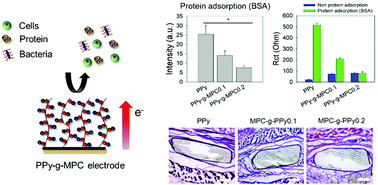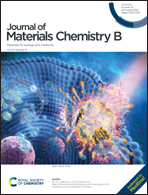Biomimetic nonbiofouling polypyrrole electrodes grafted with zwitterionic polymer using gamma rays†
Abstract
Bioelectrodes, including metallic and conductive polymer (CP) bioelectrodes, often suffer from biofouling by contamination from microbacteria and/or biomolecules in biological systems, which can cause substantial impairment of biofunctionality and biocompatibility. Herein, we have employed an in situ polymerization of methacryloyloxyethyl phosphorylcholine (MPC) by gamma radiation to introduce fouling-resistant properties onto the surface of the conductive polymer, polypyrrole (PPy). The concentrations of an MPC monomer were varied during the grafting. PPy electrodes modified with MPC (PPy-g-MPC) revealed excellent anti-biofouling properties, as demonstrated by multiple analyses, such as serum protein adsorption, fibroblast adhesion, bacteria adhesion, and scar tissue formation in vivo. Importantly, PPy-g-MPC, which was modified with 0.2 M MPC using gamma radiation, exhibited electrical properties similar to unmodified PPy electrodes, indicating that our MPC grafting strategies did not cause impairment of electrical/electrochemical properties of the original PPy electrodes while successfully introducing anti-biofouling properties. Zwitterionic MPC polymer grafting on PPy electrodes by in situ polymerization with gamma radiation will benefit the development of highly biocompatible and functional bioelectrodes, such as neural electrodes, stimulators, and biosensors.



 Please wait while we load your content...
Please wait while we load your content...